Study on Foaming Agent Foam Composite Index (FCI) Correlation with High Temperature and High Pressure for Unconventional Oil and Gas Reservoirs
Abstract
:1. Introduction
2. Experimental
2.1. Materials and Experimental Sets
2.2. Methods
2.2.1. Experimental Procedures
- (1)
- Each group was prepared with 100 mL formation water. The total salinity was 9 × 104 mg/L, the pH value was adjusted to 6, 0.3 mL pure foaming agent was added to the formation water, and then the foaming agent concentration of 3‰ was formed and added to the experimental vessel.
- (2)
- The prepared solution was added to the experimental container (the visual container’s base liquid height was 7.96 cm with an inner diameter of 4 cm) and the required temperature and pressure was set for the experiment.
- (3)
- A stirring button was used to initiate stirring of the foaming agent solution at a speed of 3000 r/min for 3 min.
- (4)
- After stirring, a stopwatch was set to start timing, and the foaming height was recorded. At the same time, the automatic camera was turned on to take a picture of the foam height every one second.
- (5)
- Timing was stopped when the precipitated liquid reached 50 mL (the liquid height was at 3.98 cm), and the cumulative time represents the foam’s half-life.
- (6)
- Different test pressures and test temperatures were used and steps (1)–(5) were repeated to find the parameters of the foaming agent’s properties under different test conditions.
2.2.2. Experimental Design
3. Foam Composite Index
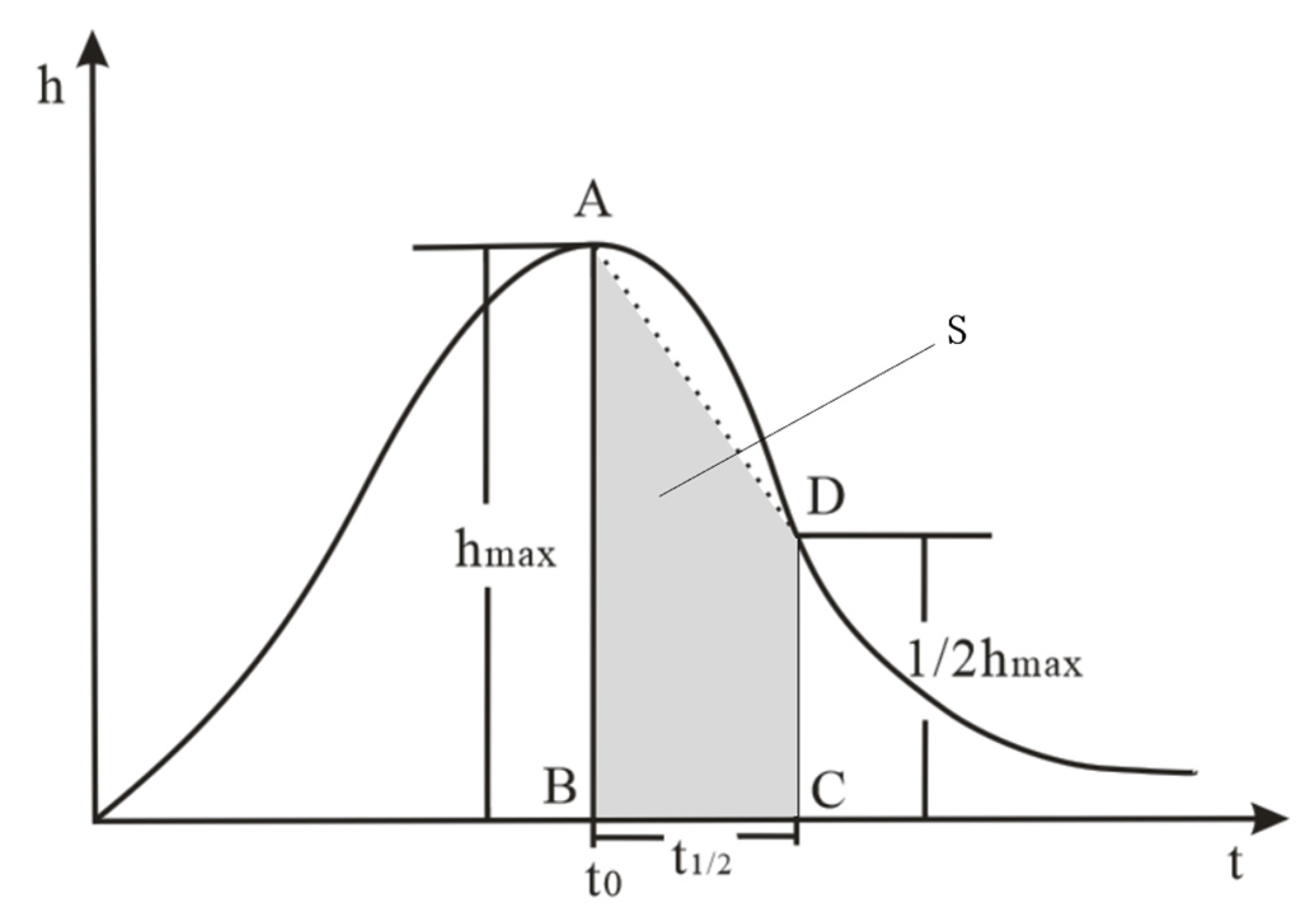
4. Results and Discussion
4.1. Foam Property of Two Foaming Agents under Temperature
4.2. Foam Property of Two Foaming Agents under Pressure
4.3. Foam Composite Index Relationship with Temperature and Pressure
| Temperature (°C) | Pressure (MPa) | Foam Height (cm) | Half-Life (s) | FCI (cm·s) | ||
|---|---|---|---|---|---|---|
| Calculated Values | Predicted Values | Relative Error Values | ||||
| 40 | 0.1 | 15.0 | 54 | 607.50 | 572.16 | −5.82% |
| 40 | 6.0 | 20.2 | 340 | 5151.00 | 4912.86 | −4.62% |
| 40 | 8.0 | 20.2 | 396 | 5999.40 | 6384.29 | 6.42% |
| 40 | 10.0 | 20.3 | 482 | 7338.45 | 7855.71 | 7.05% |
| 60 | 0.1 | 12.4 | 188 | 1748.40 | 1854.55 | 6.07% |
| 60 | 6.0 | 20.2 | 410 | 6211.50 | 6195.25 | −0.26% |
| 60 | 8.0 | 20.4 | 496 | 7588.80 | 7666.68 | 1.03% |
| 60 | 10.0 | 20.5 | 630 | 9686.25 | 9138.11 | −5.66% |
| 80 | 0.1 | 18.0 | 218 | 2943.00 | 3136.94 | 6.59% |
| 80 | 6.0 | 25.3 | 426 | 8083.35 | 7477.65 | −7.49% |
| 80 | 8.0 | 25.5 | 508 | 9715.50 | 8949.07 | −7.89% |
| 80 | 10.0 | 25.6 | 540 | 10,368.00 | 10,420.50 | 0.51% |
| 100 | 0.1 | 20.0 | 275 | 4125.00 | 4419.33 | 7.14% |
| 100 | 6.0 | 25.5 | 493 | 9428.63 | 8760.04 | −7.09% |
| 100 | 8.0 | 25.6 | 502 | 9638.40 | 10,231.46 | 6.15% |
| 100 | 10.0 | 25.7 | 573 | 11,044.58 | 11,702.89 | 5.96% |
| Temperature (°C) | Pressure (MPa) | Foam Height (cm) | Half-Life (s) | FCI (cm·s) | ||
|---|---|---|---|---|---|---|
| Calculated Values | Predicted Values | Relative Error Values | ||||
| 40 | 0.1 | 13.0 | 15 | 146.25 | 158.53 | 8.40% |
| 40 | 6.0 | 20.1 | 298 | 4492.35 | 4408.84 | −1.86% |
| 40 | 8.0 | 20.2 | 386 | 5847.90 | 5849.62 | 0.03% |
| 40 | 10.0 | 20.4 | 468 | 7160.40 | 7290.40 | 1.82% |
| 60 | 0.1 | 13.2 | 132 | 1306.80 | 1409.58 | 7.86% |
| 60 | 6.0 | 20.2 | 389 | 5893.35 | 5659.88 | −3.96% |
| 60 | 8.0 | 20.3 | 451 | 6866.48 | 7100.67 | 3.41% |
| 60 | 10.0 | 20.6 | 527 | 8142.15 | 8541.45 | 4.90% |
| 80 | 0.1 | 16.0 | 225 | 2700.00 | 2660.62 | −1.46% |
| 80 | 6.0 | 23.2 | 407 | 7081.80 | 6910.93 | −2.41% |
| 80 | 8.0 | 23.4 | 511 | 8968.05 | 8351.71 | −6.87% |
| 80 | 10.0 | 23.5 | 576 | 10,152.00 | 9792.49 | −3.54% |
| 100 | 0.1 | 18.0 | 267 | 3604.50 | 3911.67 | 8.52% |
| 100 | 6.0 | 23.3 | 475 | 8300.63 | 8161.98 | −1.67% |
| 100 | 8.0 | 23.4 | 562 | 9863.10 | 9602.76 | −2.64% |
| 100 | 10.0 | 23.5 | 586 | 10,328.25 | 11,043.54 | 6.93% |
5. Conclusions
- (1)
- A scheme to test foaming capacity under high temperature and high pressure was designed. The evaluation set, UPMX-500, was utilized to determine the foam height and half-life of the foaming agent under conditions of high temperature and pressure. The foam height and half-life demonstrated a general upward trend as the pressure and temperature increased, although the specific changes in the foam height or half-life tended to exhibit intermittent points of fluctuation or slower growth.
- (2)
- The foam properties under high temperature and high pressure were quantitatively evaluated using the foam composite index. The foam composite index, FCI, of the two foaming agents is positively correlated with pressure and temperature, the coefficients of determination are 0.9799 and 0.9895, respectively, and the error is less than 10%.
- (3)
- According to the foam composite index correlation with pressure and temperature, the influence of pressure is greater than temperature. This correlation can provide a reference for accurately predicting foaming ability and qualitative evaluation of the liquid-carrying capacity, plugging capacity and oil-displacement capacity of the foaming agent under different pressure and temperature conditions.
Author Contributions
Funding
Data Availability Statement
Conflicts of Interest
References
- Khattab, H.; Gawish, A.A.; Hamdy, A.; Gomaa, S.; El-hoshoudy, A.N. Assessment of a Novel Xanthan Gum-based Composite for Oil Recovery Improvement at Reservoir Conditions; Assisted with Simulation and Economic Studies. J. Polym. Environ. 2024, 1, 1–29. [Google Scholar] [CrossRef]
- Salem, K.G.; Tantawy, M.A.; Gawish, A.A.; Gomaa, S.; El-hoshoudy, A.N. Nanoparticles assisted polymer flooding: Comprehensive assessment and empirical correlation. Geoenergy Sci. Eng. 2023, 226, 211753. [Google Scholar] [CrossRef]
- Tananykhin, D.S.; Struchkov, I.A.; Khormali, A.; Roschin, P.V. Investigation of the influences of asphaltene deposition on oilfield development using reservoir simulation. Pet. Explor. Dev. 2022, 49, 1138–1149. [Google Scholar] [CrossRef]
- Luo, Y.; Chen, M.; Liu, D.; Jin, Y.; Du, M.; Hou, J. Technology and applications of foam drilling fluid in fractured and complex formations. Pet. Sci. Technol. 2012, 30, 1747–1754. [Google Scholar] [CrossRef]
- Sun, J.; Bai, Y.; Cheng, R.; Lyu, K.; Liu, F.; Feng, J.; Lei, S.; Zhang, J.; Hao, H. Research progress and prospect of plugging technologies for fractured formation with severe lost circulation. Pet. Explor. Dev. 2021, 48, 732–743. [Google Scholar] [CrossRef]
- Ivanova, T.N.; Żabińska, I. Modern methods of elimination of lost circulation in directional wells. Manag. Syst. Prod. Eng. 2021, 29, 65–74. [Google Scholar] [CrossRef]
- Li, D.; Li, F.; Deng, S.; Liu, J.; Huang, Y.; Yang, S. Preparation of oil-based foam gel with nano-SiO2 as foam stabilizer and evaluation of its performance as a plugging agent for fractured shale. Geofluids 2022, 2022, 9539999. [Google Scholar] [CrossRef]
- Li, Y.; Dai, C.; Wu, Y.; Wang, R. A new type of gelled foam plugging agent with resistance to temperature, salt and dilution. IOP Conf. Ser. Earth Environ. Sci. 2020, 565, 012051. [Google Scholar] [CrossRef]
- Blaker, T.; Aarra, M.G.; Skauge, A.; Rasmussen, L.; Celius, H.K.; Martinsen, H.A.; Vassenden, F. Foam for gas mobility control in the Snorre field: The FAWAG project. SPE Reserv. Eval. Eng. 2002, 5, 317–323. [Google Scholar] [CrossRef]
- Borchardt, J.K.; Bright, D.B.; Dickson, M.K.; Wellington, S.L. Surfactants for CO2 foam flooding. In Proceedings of the SPE Annual Technical Conference and Exhibition, Las Vegas, NV, USA, 22 September 1985. SPE-14394-MS. [Google Scholar]
- Farajzadeh, R.; Andrianov, A.; Bruining, H.; Zitha, P.L. Comparative study of CO2 and N2 foams in porous media at low and high pressure−temperatures. Ind. Eng. Chem. Res. 2009, 48, 4542–4552. [Google Scholar] [CrossRef]
- Liu, Y.; Yuan, X.; Bao, Y. Experimental Evaluation Study on High Temperature Tolerance Foam for Profile Control of Steam Huff-n-Puff. Geofluids 2022, 2022, 1433998. [Google Scholar] [CrossRef]
- Beggs, D.H.; Brill, J.P. A study of two-phase flow in inclined pipes. J. Pet. Technol. 1973, 25, 607–617. [Google Scholar] [CrossRef]
- Solesa, M.; Sevic, S. Production Optimization Challenges of Gas Wells with Liquid Loading Problem Using Foaming Agents. In Proceedings of the SPE Russian Oil and Gas Technical Conference and Exhibition, Moscow, Russia, 3 October 2006; SPE-101276-MS. [Google Scholar]
- Heiles, B.; Zadrazil, I.; Matar, O. The effect of surfactant on stratified and stratifying gas-liquid flows. In Proceedings of the 66th Annual Meeting of the APS Division of Fluid Dynamics, Pittsburgh, PA, USA, 24–26 November 2013; Volume 58, pp. 24–26. [Google Scholar]
- Huh, D.G.; Cochrane, T.D.; Kovarik, F.S. The Effect of Microscopic Heterogeneity on CO2-Foam Mobility: Part 1—Mechanistic Study. J. Can. Pet. Technol. 1989, 41, 872–879. [Google Scholar] [CrossRef]
- Rossen, W.R.; Zeilinger, S.C.; Shi, J.X.; Lim, M.T. Simplified Mechanistic Simulation of Foam Processes in Porous Media. SPE J. 1999, 4, 279–287. [Google Scholar] [CrossRef]
- Kim, J.S.; Dong, Y.; Rossen, W.R. Steady-State Flow Behavior of CO2 Foam. SPE J. 2008, 10, 405–415. [Google Scholar] [CrossRef]
- Ma, K.; Ren, G.W.; Mateen, K.; Morel, D.; Cordelier, P. Modeling Techniques for Foam Flow in Porous Media. SPE J. 2015, 20, 453–470. [Google Scholar] [CrossRef]
- Dong, P.F.; Puerto, M.; Jian, G.Q.; Ma, K.; Mateen, K.; Ren, G.W.; Bourdarot, G.; Morel, D.; Biswal, S.L.; Hirasaki, G. Exploring Low-IFT Foam EOR in Fractured Carbonates: Success and Particular Challenges of Sub-10-md Limestone. SPE J. 2020, 25, 867–882. [Google Scholar] [CrossRef]
- Lyu, X.C.; Voskov, D.; Tang, J.Y.; Rossen, W.R. Simulation of Foam Enhanced-Oil-Recovery Processes Using Operator-Based Linearization Approach. SPE J. 2021, 26, 2287–2304. [Google Scholar] [CrossRef]
- Zhao, X.D.; Zhong, Y. Method for evaluation of Foaming Agent Removing Water from Gas Well. J. Southwest Pet. Inst. 1991, 13, 96–100. [Google Scholar]
- Li, Q.D.; Lu, Y.B.; Li, S.J.; Li, H.J. Development and performance evaluation of a new efficient foam discharging agent LYB-1. Nat. Gas Ind. 2011, 31, 49–51. [Google Scholar]
- Liu, J.C.; Yang, M.; Yuan, F.F. Foam Properties of New Foaming Composition SP for Bottom Liquid Withdrawal from Gas Production Well. Oilfield Chem. 2008, 25, 111–114. [Google Scholar]
- Quintero, L. An overview of surfactant applications in drilling fluids for the petroleum industry. J. Dispers. Sci. Technol. 2002, 23, 393–404. [Google Scholar] [CrossRef]
- Wang, J.L.; Nguyen, A.V.; Farrokhpay, S. A critical review of the growth, drainage and collapse of foams. Adv. Colloid Interface Sci. 2016, 228, 55–70. [Google Scholar] [CrossRef] [PubMed]
- Guan, J.; Liang, L.; Zhao, Y.L.; Sun, N.; Lu, W.; Zhen, Y. Study on screening and evaluation of foam drainage agents for gas wells with high temperature and high pressure. ACS Omega 2023, 8, 7940–7949. [Google Scholar] [CrossRef] [PubMed]
- Telmadarreie, A.; Trivedi, J.J. Static and dynamic performance of wet foam and polymer-enhanced foam in the presence of heavy oil. Colloids Interfaces 2018, 2, 38. [Google Scholar] [CrossRef]
- Wang, Y.X.; Cao, Y.Q.; Zhang, Q.; Meng, Q. Novel cationic gemini surfactants based on piperazine: Synthesis, surface activity, and foam ability. J. Dispers. Sci. Technol. 2016, 37, 465–471. [Google Scholar] [CrossRef]
- Duan, X.; Hou, J.; Cheng, T.; Li, S.; Ma, Y. Evaluation of oil-tolerant foam for enhanced oil recovery: Laboratory study of a system of oil-tolerant foaming agents. J. Pet. Sci. Eng. 2014, 122, 428–438. [Google Scholar] [CrossRef]
- Wang, H.; Guo, W.; Zheng, C.; Wang, D.; Zhan, H. Effect of temperature on foaming ability and foam stability of typical surfactants used for foaming agent. J. Surfactants Deterg. 2017, 20, 615–622. [Google Scholar] [CrossRef]
- Hamza, M.F.; Soleimani, H.; Merican ZM, A.; Sinnathambi, C.M.; Stephen, K.D.; Ahmad, A.A. Nano-fluid viscosity screening and study of in situ foam pressure buildup at high-temperature high-pressure conditions. J. Pet. Explor. Prod. Technol. 2020, 10, 1115–1126. [Google Scholar] [CrossRef]
- Zhang, C.L.; Wang, P.; Song, G.L. Study on enhanced oil recovery by multi-component foam flooding. J. Pet. Sci. Eng. 2019, 177, 181–187. [Google Scholar] [CrossRef]
- Liang, S.; Hu, S.Q.; Li, J.; Xu, G.; Zhang, B.; Zhao, Y.; Yan, H.; Li, J. Study on EOR method in offshore oilfield: Combination of polymer microspheres flooding and nitrogen foam flooding. J. Pet. Sci. Eng. 2019, 178, 629–639. [Google Scholar] [CrossRef]
- Cao, G.Q.; Wang, Y.; Li, N. A New Experimental Evaluation Technology for Foaming Agent in High Temperature and High Pressure Formation. Adv. Mater. Res. 2014, 962, 877–882. [Google Scholar] [CrossRef]

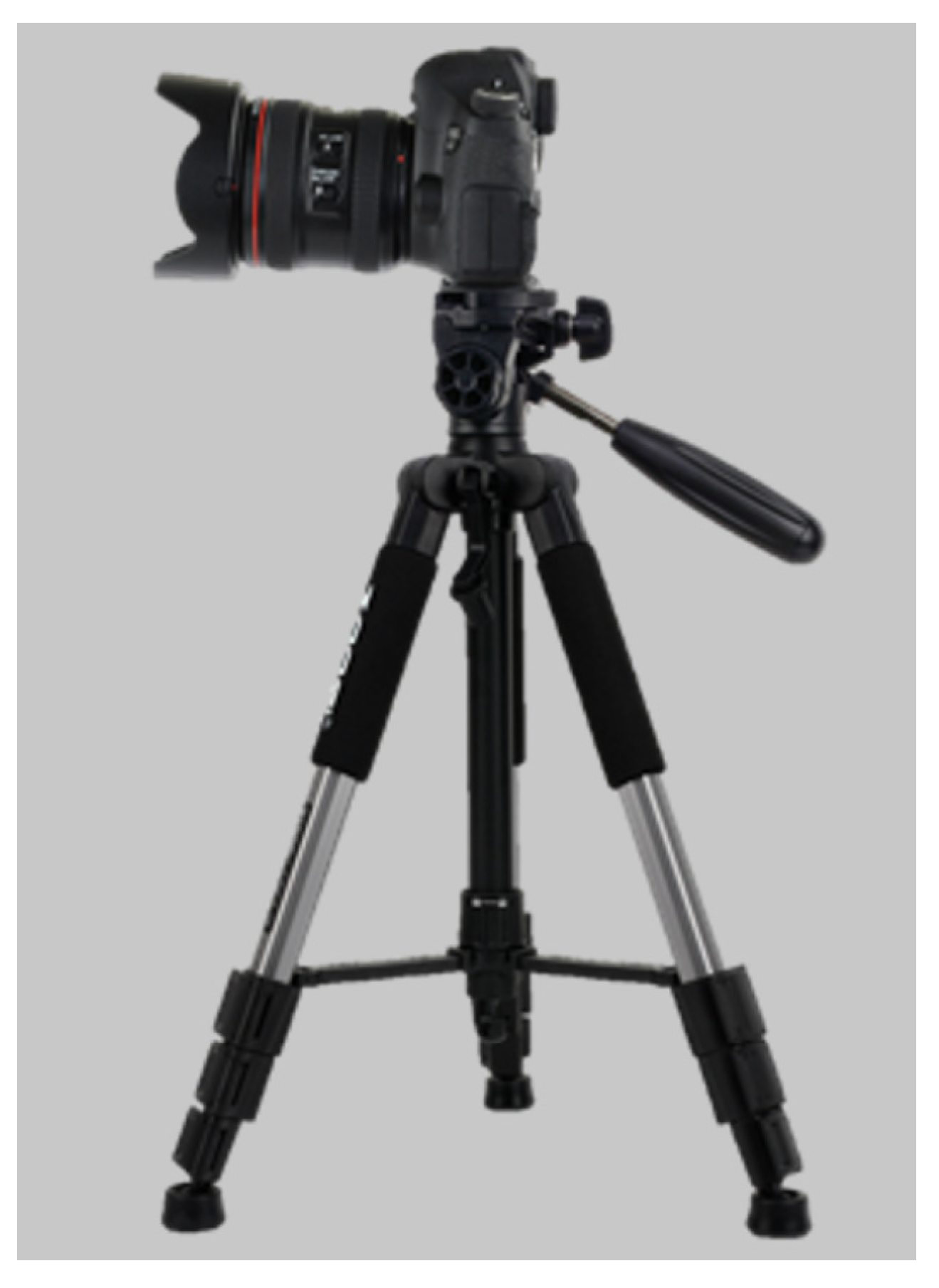
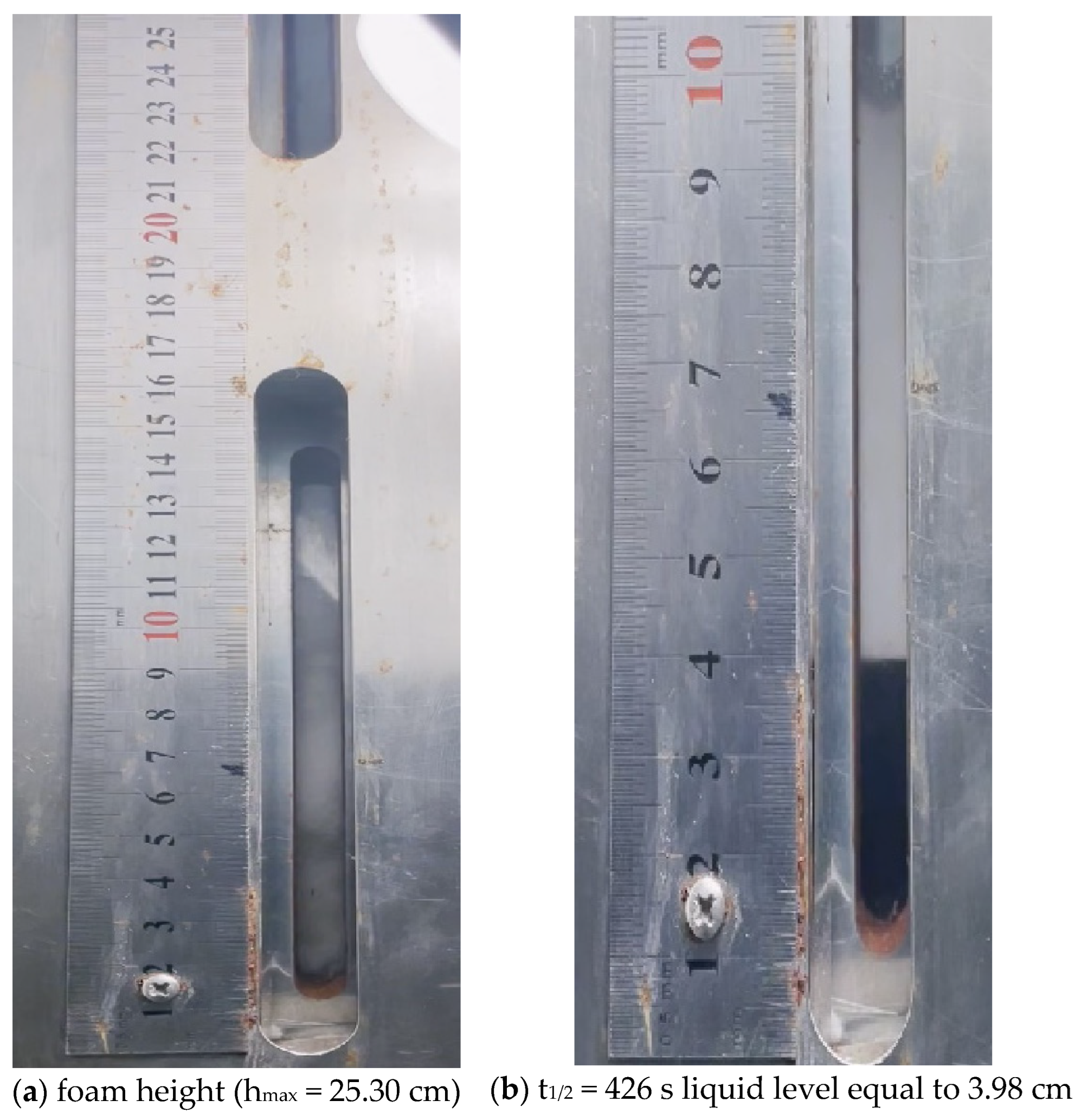

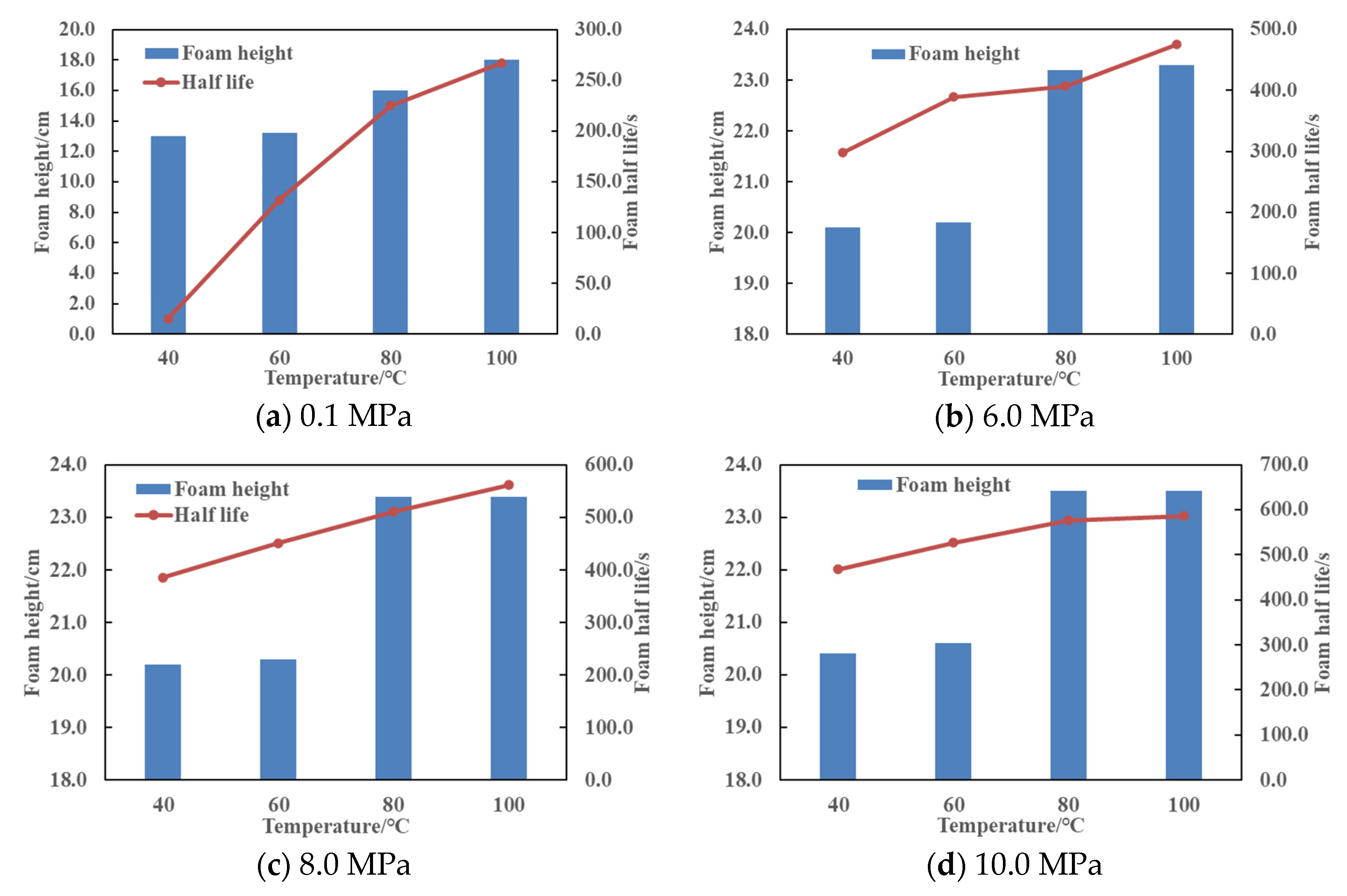


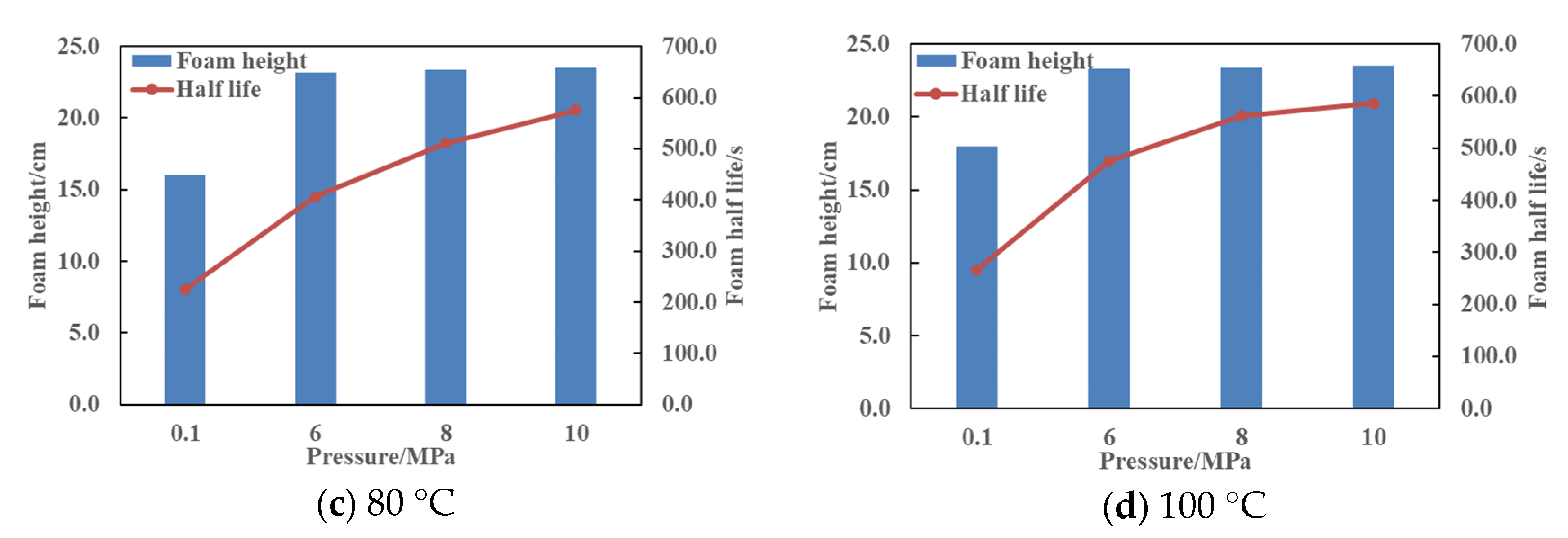
| Type | Manufacturer | Chemical Composition |
|---|---|---|
| UT-7 | Chengdu Fuji technology Co., LTD, Chengdu, China | polyol complex surfactant |
| HY-3K | Sichuan Hengyi Petroleum Technical Service Co., LTD, Chengdu, China | complex of sodium dodecyl benzene sulfonate and sodium alpha-olefin sulfonate |
| Simulated formation water | Gas well, Linfen, China | total salinity: 9 × 104 mg/L, pH = 6 (K+: 269.4 mg/L, Na+: 7554.26 mg/L, Ca2+: 9006.8 mg/L, Mg2+: 781.9 mg/L, Zn2+: 4215.7 mg/L, Ba2+: 393.3 mg/L, F−: 4.3 mg/L, Cl−: 30,456.6 mg/L, Br−: 107.7 mg/L, NO3−: 47.7 mg/L, SO43−: 66.7 mg/L, HCO33−: 2274.6 mg/L) |
| N.O. | Foam Agent Type | Temperature (°C) | Pressure (MPa) | N.O. | Foam Agent Type | Temperature (°C) | Pressure (MPa) |
|---|---|---|---|---|---|---|---|
| 1 | UT-7 | 40 | 0.1 | 17 | HY-3K | 40 | 0.1 |
| 2 | 6.0 | 18 | 6.0 | ||||
| 3 | 8.0 | 19 | 8.0 | ||||
| 4 | 10.0 | 20 | 10.0 | ||||
| 5 | 60 | 0.1 | 21 | 60 | 0.1 | ||
| 6 | 6.0 | 22 | 6.0 | ||||
| 7 | 8.0 | 23 | 8.0 | ||||
| 8 | 10.0 | 24 | 10.0 | ||||
| 9 | 80 | 0.1 | 25 | 80 | 0.1 | ||
| 10 | 6.0 | 26 | 6.0 | ||||
| 11 | 8.0 | 27 | 8.0 | ||||
| 12 | 10.0 | 28 | 10.0 | ||||
| 13 | 100 | 0.1 | 29 | 100 | 0.1 | ||
| 14 | 6.0 | 30 | 6.0 | ||||
| 15 | 8.0 | 31 | 8.0 | ||||
| 16 | 10.0 | 32 | 10.0 |
Disclaimer/Publisher’s Note: The statements, opinions and data contained in all publications are solely those of the individual author(s) and contributor(s) and not of MDPI and/or the editor(s). MDPI and/or the editor(s) disclaim responsibility for any injury to people or property resulting from any ideas, methods, instructions or products referred to in the content. |
© 2024 by the authors. Licensee MDPI, Basel, Switzerland. This article is an open access article distributed under the terms and conditions of the Creative Commons Attribution (CC BY) license (https://creativecommons.org/licenses/by/4.0/).
Share and Cite
Wu, J.; Ma, W.; Liu, Y.; Qi, W.; Wang, H.; Ji, G.; Luo, W.; Liu, K. Study on Foaming Agent Foam Composite Index (FCI) Correlation with High Temperature and High Pressure for Unconventional Oil and Gas Reservoirs. Processes 2024, 12, 1426. https://doi.org/10.3390/pr12071426
Wu J, Ma W, Liu Y, Qi W, Wang H, Ji G, Luo W, Liu K. Study on Foaming Agent Foam Composite Index (FCI) Correlation with High Temperature and High Pressure for Unconventional Oil and Gas Reservoirs. Processes. 2024; 12(7):1426. https://doi.org/10.3390/pr12071426
Chicago/Turabian StyleWu, Jianjun, Wentao Ma, Yinhua Liu, Wei Qi, Haoyu Wang, Guofa Ji, Wei Luo, and Kai Liu. 2024. "Study on Foaming Agent Foam Composite Index (FCI) Correlation with High Temperature and High Pressure for Unconventional Oil and Gas Reservoirs" Processes 12, no. 7: 1426. https://doi.org/10.3390/pr12071426
APA StyleWu, J., Ma, W., Liu, Y., Qi, W., Wang, H., Ji, G., Luo, W., & Liu, K. (2024). Study on Foaming Agent Foam Composite Index (FCI) Correlation with High Temperature and High Pressure for Unconventional Oil and Gas Reservoirs. Processes, 12(7), 1426. https://doi.org/10.3390/pr12071426






